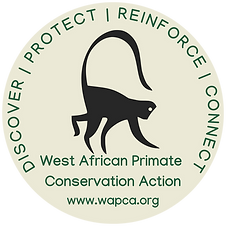





Cape Three Point Reserve Community Project

The Cape Three Points Forest Reserve, located along Ghana’s western coastline, is one of the last remaining coastal rainforests in West Africa. Recognised as a Global Significant Biodiversity Area (GSBA), Key Biodiversity Area (KBA) and Important Bird Area (IBA), the reserve supports rare and endemic species, including threatened primates, forest birds, and a diverse range of plant life.
Despite its protected status under the Forestry Commission of Ghana, limited government resources have made it difficult to control illegal activities such as logging, mining, and hunting. To address these challenges, WAPCA, in partnership with Hen Mpoano and the Forest Services Division, supports the establishment of a Community Resource Management Area (CREMA). This initiative empowers local people to take an active role in protecting and restoring the forest while developing sustainable sources of income.
Implementation and Community Action
Strengthening Local Conservation Governance
The Cape Three Points CREMA is guided by a locally elected committee representing surrounding communities. With training and technical support from WAPCA and Hen Mpoano, committee members participate in workshops on community advocacy, communication, and forest law enforcement. Through outreach activities such as radio programmes, community theatre, and participatory video, the CREMA raises awareness about the impacts of illegal chainsaw operations and promotes local stewardship of forest resources.
Community Forest Monitoring
To protect the reserve and its buffer zones, WAPCA and the Wildlife Division have trained local residents as part of the Community Forest Monitoring Team (CFMT). These teams conduct regular patrols, record illegal activities, and collaborate with the Forest Services Division to strengthen law enforcement. Refresher training on the use of the Event Book System has improved record-keeping and data collection, while literacy support ensures all members can contribute effectively. Patrols remain crucial in safeguarding the reserve from illegal mining and logging.
Forest Restoration
Forest restoration is a core focus of the Cape Three Points project. Community nurseries cultivate native tree species—including mahogany, emire, ofram, teak, and cedrella, for use in replanting degraded areas and creating community-managed woodlots.
In the past year alone, over 62,000 seedlings were raised for planting, with additional seedlings distributed to partner organisations, schools, and nearby reserves. These efforts help rebuild forest cover, protect watersheds, and restore habitat for wildlife.
Environmental Awareness and Education
WAPCA works closely with local communities and schools to increase understanding of forest conservation and sustainable resource use. Radio discussions, school outreach, and CREMA Sports for Conservation events engage residents of all ages.
Topics include the ecological importance of forests, the impact of illegal mining, and the benefits of alternative livelihoods, helping foster a shared commitment to protecting the reserve.
Sustainable Livelihoods and Community Development
To reduce pressure on forest resources, WAPCA supports green value chains and alternative income-generating activities such as beekeeping and eco-tourism. In collaboration with Bees Abroad, community members receive training in hive management, honey production, and harvest techniques, enabling them to earn sustainable incomes while promoting forest conservation.
In addition, WAPCA funds community-led development projects identified through the CREMA. A recent example includes the installation of a borehole facility in Animakrom, providing clean water for residents and strengthening community support for conservation.
Through these ongoing partnerships with the Wildlife Division, Hen Mpoano, and local communities, WAPCA continues to strengthen the Cape Three Points CREMA as a model for sustainable, community-led rainforest protection, demonstrating how empowering people to manage their own resources can safeguard biodiversity while improving livelihoods.

